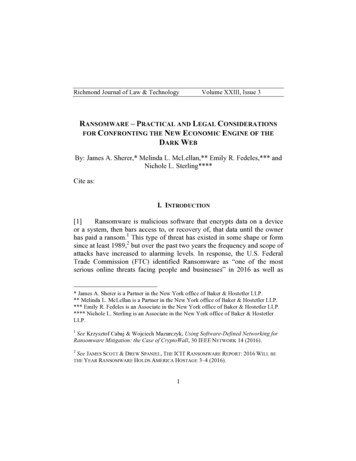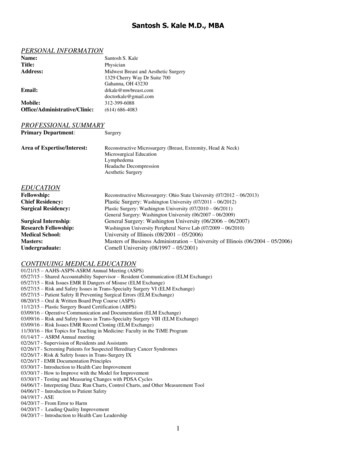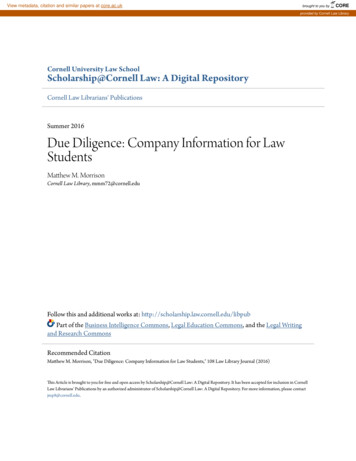
Transcription
Richmond Journal of Law & TechnologyVolume XXIII, Issue 3RANSOMWARE – PRACTICAL AND LEGAL CONSIDERATIONSFOR CONFRONTING THE NEW ECONOMIC ENGINE OF THEDARK WEBBy: James A. Sherer,* Melinda L. McLellan,** Emily R. Fedeles,*** andNichole L. Sterling****Cite as:I. INTRODUCTION[1]Ransomware is malicious software that encrypts data on a deviceor a system, then bars access to, or recovery of, that data until the ownerhas paid a ransom.1 This type of threat has existed in some shape or formsince at least 1989,2 but over the past two years the frequency and scope ofattacks have increased to alarming levels. In response, the U.S. FederalTrade Commission (FTC) identified Ransomware as “one of the mostserious online threats facing people and businesses” in 2016 as well as* James A. Sherer is a Partner in the New York office of Baker & Hostetler LLP.** Melinda L. McLellan is a Partner in the New York office of Baker & Hostetler LLP.*** Emily R. Fedeles is an Associate in the New York office of Baker & Hostetler LLP.**** Nichole L. Sterling is an Associate in the New York office of Baker & HostetlerLLP.1See Krzysztof Cabaj & Wojciech Mazurczyk, Using Software-Defined Networking forRansomware Mitigation: the Case of CryptoWall, 30 IEEE NETWORK 14 (2016).2See JAMES SCOTT & DREW SPANIEL, THE ICIT RANSOMWARE REPORT: 2016 WILL BETHE YEAR RANSOMWARE HOLDS AMERICA HOSTAGE 3–4 (2016).1
Richmond Journal of Law & TechnologyVolume XXIII, Issue 3“the most profitable form of malware criminals use,”3 and the FBIdeveloped a special working group dedicated to fighting it.4[2]Considering that Ransomware emerged “at the dawn of theInternet revolution,”5 even before the development of formalized Internetlaw and policy, attorneys have now had a bit of time to become familiarwith its operation and effects and to contemplate reasonable and legitimateresponses to Ransomware attacks. Despite the intervening decades, andalthough Ransomware as a process and business are (somewhat) betterunderstood, the legal implications of Ransomware attacks are still up fordebate, and there is no simple answer to the question of how Ransomwarevictims can, or should, deal with an attack.[3]This digital menace poses constantly evolving threats, which addsto the challenges victims confront when attempting to implement currentguidance and benchmarked response efforts to Ransomware. Thesechallenges are not only rooted in functionality and potential damage, butalso due to the emergence of a viable business model facilitatingRansomware’s exponential growth as a tool for criminals. We will explorethese challenges by providing an overview of Ransomware’s developmentand spread and then examining the current, albeit unsettled, legal3Ben Rossen, How to Defend Against Ransomware, FTC (Nov. 10, e Paul Merrion, FBI Creates Task Force to Fight Ransomware Threat, CQ ROLLCALL, Apr. 4, 2016, 2016 WL 2758516.5Robert E. Litan, Law and Policy in the Age of the Internet, 50 DUKE L.J. 1045, 1045(2001).2
Richmond Journal of Law & TechnologyVolume XXIII, Issue 3landscape surrounding Ransomware attacks and victim responses, toconsider what the future might hold for regulation in this space.II. A HISTORY OF RANSOMWARE[4]As noted above, Ransomware has been around in one form oranother for at least ten years,6 and as early as 1989 in the U.S.7 andEurope.8 The first recorded example was biologist Joseph Popp’s “AIDSTrojan”: Popp developed the virus and “passed 20,000 infected floppydisks out at the 1989 World Health Organization’s AIDS conference.”9Ransomware subsequently faded as a notable security concern for morethan a decade before making another brief appearance in 2005.10 Then, inthe wake of an economic recession, Ransomware came back with avengeance, making a dramatic entrance as it “resurged in 2013;”11 it has6See Amin Kharraz et al., Cutting the Gordian Knot: A Look Under the Hood ofRansomware Attacks, in DIMVA 2015 PROCEEDINGS OF THE 12TH INTERNATIONALCONFERENCE ON DETECTION OF INTRUSIONS AND MALWARE, AND VULNERABILITYASSESSMENT 3 (Springer 2015).7See James Scott & Drew Spaniel, supra note 2, at 4.8NICOLE VAN DER MEULEN ET AL., EUROPEAN PARLIAMENT POLICY DEP'T FOR CITIZENS'RIGHTS & CONSTITUTIONAL AFFAIRS, CYBERSECURITY IN THE EUROPEAN UNION ANDBEYOND: EXPLORING THE THREATS AND POLICY RESPONSES 35 s/STUD/2015/536470/IPOL STU(2015)536470 EN.pdf, https://perma.cc/6M58-B4TW.9James Scott & Drew Spaniel, supra note 2, at 6.10See id.11See VAN DER MEULEN, supra note 8, at 35.3
Richmond Journal of Law & TechnologyVolume XXIII, Issue 3continued to flourish ever since. Interestingly, Ransomware’s recentreemergence may be explained, in part, by the success of other hackingefforts. The historical model for the most obvious cybercrimes had beenstealing and selling data (usually credit card numbers), but this fraudbecame so prevalent that the going rate for stolen payment cardinformation has dropped precipitously over the past five years.12 Inresponse, “[t]o keep cybercrime profitable, criminals needed to find a newcohort of potential buyers, and they did: all of us.”13[5]Although experts rightly emphasize the significant problemRansomware presents today, the risks have not always been so grave inthe hostage-software industry. As Doug Pollack noted, “ironically, until[the 2005 resurgence], most [Ransomware] was fake. Fraudulent spywareremoval tools and performance optimizers scared users into paying to fixproblems that didn’t really exist.”14 Regardless, most present-day (and,likely, future) Ransomware is serious business, both in the effects it has onvictims and in the underground infrastructure that buttressesRansomware’s propagation. Moreover, the scourge of Ransomware is12See Josephine Wolff, The New Economics of Cybercrime, THE ATLANTIC (June 7,2016), 6/ransomware-neweconomics-cybercrime/485888/, https://perma.cc/5L3U-47CT.13Id.14DOUG POLLACK, RANSOMWARE 101: WHAT TO DO WHEN YOUR DATA IS HELDHOSTAGE 7 (2016) (ebook), /f051f/1/-/-/-/-/IDE eBook Ransomware 082616 v1.pdf?cm mmc Act-On%20Software -email- 20Hostage- -Download%20Now&sid TV2:dA7ip6myT,https://perma.cc/327S-TXFL.4
Richmond Journal of Law & TechnologyVolume XXIII, Issue 3growing steadily, with some researchers noting 500% yearly increases.15Other experts focus on the exponential reach of Ransomware, noting thatit “infects one computer but often spreads across network drives to infectother computers as well.”16[6]In the face of an inarguably immense and expanding problem, anunderstanding of the relevant legal issues is crucial for practitioners whowill encounter Ransomware and its effects. That said, evaluating theapplicable legal framework requires knowledge of Ransomware’smechanics, which may vary widely by the type, source, and purpose of theRansomware—not to mention the specific effects it may have on a givenorganization.III. RANSOMWARE AS A PROCESS[7]Malware is malicious software, but that category “encompasses awide range of program types including viruses, worms, logic bombs,Trojan horses, keyloggers, zombie programs, and backdoors.”17 Onesubcategory of Malware is “Scareware,” or Malware that “takes advantageof people’s fear of revealing their private information, losing their criticaldata, or facing irreversible hardware damage.”18 Ransomware is a subset15See Kharraz, supra note 6, at 1, 4.16See Azad Ali et al., Recovering from the Nightmare of Ransomware – How SavvyUsers Get Hit with Viruses and Malware: A Personal Case Study, 17 ISSUES ININFORMATION SYSTEMS 58, 61 (2016).17Robert J. Kroczynski, Are the Current Computer Crime Laws Sufficient or Should theWriting of Virus Code Be Prohibited?, 18 FORDHAM INTELL. PROP. MEDIA & ENT. L.J.817, 823 (2008).18See Kharraz, supra note 6, at 1.5
Richmond Journal of Law & TechnologyVolume XXIII, Issue 3of Scareware; specifically a “category of malicious software which, whenrun, disables the functionality of a computer in some way,”19 making itessentially “a digital version of hostage taking.”20 Ransomware is alsoclassified as a type of viral software, which is software that may begrouped into separate “families” and differentiated by whether it presentsonly the superficial trappings of a threat or poses an actual problem.21 Wemay divide the types of Ransomware that pose an actual threat into twomain groups: “one-off” variants used in an ad-hoc fashion, and softwarethat serves as an extension of the broader criminal infrastructure intowhich victims pay their ransom.A. Locker Ransomware[8]Beginning with the functional mechanics of the software,Ransomware attacks can be segregated by form. Early variants22 wereprimarily Locker Ransomware, and were identified as such (e.g.,19Gavin O’Gorman & Geoff McDonald, Ransomware: A Growing Menace, SYMANTECCORP. (2012) at /media/security df, https://perma.cc/F6UF-UDUL.20Eric Jardine, A Continuum of Internet-Based Crime: How the Effectiveness ofCybersecurity Policies Varies across Cybercrime Types, RESEARCHGATE, 10 (Jan. 2016),reprinted in RESEARCH HANDBOOK ON DIGITAL TRANSFORMATIONS 421 (F. XavierOlleros & Majinda Zhegu eds., 2016).21See Kharraz, supra note 6, at 2.22See, e.g., William Largent, Ransomware: Past, Present, and Future, TALOS BLOG(Apr. 11, 2016, 9:01 AM), ,https://perma.cc/QU27-WDRK (last visited Feb. 6, 2017).6
Richmond Journal of Law & TechnologyVolume XXIII, Issue 3WinLocker, which would lock up a user’s screen, and Master BootRecord, which would interrupt a user’s normal operating system).23 TheLocker approach “restricts user access to infected systems by locking upthe interface or computing resources within the system,”24 therebyblocking off access to the computer or denying access to files.25 LockerRansomware may display “a message that demands payment to restorefunctionality,”26 such that it appears similar to the other Ransomwarevariants discussed below, but operates quite differently.[9]If the victim’s operating system is imagined as a storage unit,where the worth of the operating system lies in the items contained withinthe unit, Locker Ransomware operates by effectively changing the lock onthe door, or, in some cases, changing the mechanism by which the lockengages. The items within the storage unit remain untouched, and thevictim is asked to pay to have the door unlocked (or to have the lockingmechanism restored to its original form), but victims in such LockerRansomware cases have other options for regaining access. For example,they can try to bypass the door by (metaphorically) drilling out the lock,taking the door off its hinges, or just removing the walls from around theunit’s contents.23See Ian T. Ramsey & Edward A. Morse, Cyberspaxe Law Comm. Winter WorkingGrp., Ransoming Data: Technological and Legal Implications of Payments for DataPrivacy 4–5 (Jan. 29-30, 2016) (unpublished manuscript) (on file with ter/Ramsey Ransoming-data Jan2016.pdf,https://perma.cc/H4BZ-UHY3.24Pollack, supra note 14, at 7.25See Largent, supra note 22.26See O’Gorman & McDonald, supra note 19, at 2.7
Richmond Journal of Law & TechnologyVolume XXIII, Issue 3B. Crypto Ransomware[10] Cryptographic approaches to Ransomware operate differently,though the initial message—pay us or you cannot access your data—looksthe same at first blush. Rather than focusing solely on the lock, however,these variants27 employ a Crypto Ransomware or CryptoLockerapproach.28 Here, the Ransomware “encrypts files on the target system sothat the computer is still usable, but users can’t access their data.”29 Thistype of Ransomware typically “uses RSA 2048 encryption to encryptfiles,” making “cracking the lock” to avoid paying ransom animpossibility; for an average desktop computer, this approach would take“around 6.4 quadrillion years.”30[11] Continuing with the storage unit metaphor, a Crypto Ransomwareapproach may or may not tamper with the lock on the front door. Instead,Crypto Ransomware sizes up each item within the unit, systematicallydetermining the relative value of the files to the user. These may include,for example, unstructured data comprised of user photos, Worddocuments, Excel files, or PDFs. Once those files are identified by27See, e.g., Largent, supra note 22.28See id.29Doug Pollack, Trading in Fear: The Anatomy of Ransomware, ID EXPERTS (May 2,2016), -in-fear-the-anatomy-ofransomware, https://perma.cc/7VTU-5QAC.30ADAM ALESSANDRINI, RANSOMWARE HOSTAGE RESCUE MANUAL 2, /AST-0147692 Ransomware-Hostage-RescueManual.pdf, https://perma.cc/9V7T-L4YA.8
Richmond Journal of Law & TechnologyVolume XXIII, Issue 3extension, the program goes to work, encrypting each file and rendering itunusable pending payment of the ransom—unless, as we discuss below,(1) the user can find a workaround solution online; or (2) the ransom ispaid but no key is provided.[12] When it comes to Crypto Ransomware, there is no option to drillout the lock, take the door off the hinges, or tear down the wall; each fileis locked up separately and indefinitely.31 Accordingly, this type ofRansomware poses a very different kind of threat and, as such, is handledquite differently by experienced security professionals tasked with solvingthe problem.[13] Crypto Ransomware doesn’t stop there. Certain variants add insultto injury, as some may, “while encrypting files, search[] and steal[][B]itcoins from the user.”32 Others, called “Doxware,” may focus on areasnormally associated with user privacy such as conversations, photos, andother sensitive files; and threaten to release them publicly unless theransom is paid.33 Still another form of Crypto Ransomware, Shadowlock,31Considerations associated with quantum computing and decryption are outside thepurview of this paper.32Ramsey & Morse, supra note 23, at 5.33Chris Ensey, Ransomware Has Evolved, And Its Name Is Doxware, DARKREADING(Jan. 4, 2017, 07:30 AM) 7767, https://perma.cc/VGJ6-HUHD (notingalso that this would be one way of getting back access to at least some of the hostagefiles).9
Richmond Journal of Law & TechnologyVolume XXIII, Issue 3“forces users to complete consumer surveys of products and services asthe ransom payment.”34[14] Although Ransomware’s efficacy has improved over the decadessince its introduction, many earlier forms are still in use.35 This may bedue in part to its inherent longevity, as one key element of olderRansomware’s functionality is the malicious way in which its selfpropagating features make it incredibly difficult to eliminate. Some legacyRansomware variations are no longer in circulation, but certain“[m]alware that was released years—in some cases, decades—ago is stillalive and well today,”36 making awareness of modern Ransomware’sprogenitors required knowledge for practitioners active in this space.C. Ransomware Delivery[15] Despite the automated nature of Ransomware’s self-propagation,the spread of most Ransomware is still a personal process that relies onhuman error.37 The FBI notes specifically that “Ransomware is frequently34Technical Intricacies of Ransomware and Safeguarding Strategies, FALL 2016 ENEWSLETTER (Digital Mountain, Santa Clara, C.A.), 2016, at 1,http://digitalmountain.com/enews/FALL 2016 Article2.pdf, https://perma.cc/8CKR3Q3A.35See Largent, supra note 22.36Id.37See id.10
Richmond Journal of Law & TechnologyVolume XXIII, Issue 3delivered through spear phishing emails” to end users.38 Other commonmethods of installing Ransomware are “exploit kits,”39 “Web exploits anddrive-by downloads,”40 “infected removable drives, infected softwareinstallers,”41 and “mass phishing campaigns.”42 In a “mass phishingcampaign,”43 malware is “installed on a user’s computer without theirknowledge when that user browses to a compromised website,”44 and isusing “outdated browsers, browser plugins, and other software.”45 Thesetechniques may be referred to as “malvertising” where “[c]ybercriminalsleverage compromised advertising networks to serve maliciousadvertisements on legitimate websites which subsequently infect the38See U.S. DEP'T OF JUSTICE, PROTECTING YOUR NETWORKS FROM RANSOMWARE 71/download, https://perma.cc/3GT6ARH.39See Largent, supra note 22, at 1.40See O’Gorman & McDonald, supra note 19, at 4.41See Practical Steps to Thwart Ransomware and other Cyberbreaches, YOURABA(Dec. 2016), nd-other-cyber-attacks.html, https://perma.cc/U5G4VX97.42See Largent, supra note 22.43Id.44See O’Gorman & McDonald, supra note 19, at 4.45FED. BUREAU OF INVESTIGATION, are e-version.pdf, https://perma.cc/66XLV4J7.11
Richmond Journal of Law & TechnologyVolume XXIII, Issue 3visitors.[later] redirecting the user to an Exploit Kit (EK) landingpage.”46[16] In addition to leveraging self-propagation, Ransomware schemesalso may rely on the “spray and pray” technique, or sending out massivequantities of malware-infected emails in hopes of hitting “as manyindividual targets as quickly as possible” by virtue of sheer volume.47Still other types of Ransomware have begun to deploy an even morepersonal approach, tailoring messages to appear as genuine as possible;often through social engineering research used to gain knowledge of acompany’s operational structure, invoicing and remittance practices, andeven individuals’ writing styles.48 Increasingly, “e-mails are highlytargeted to both the organization and individual, making scrutiny of thedocument and sender important to prevent exploitation.”49D. Personality and Psychology[17] The customization of these programs is reflected in a variety offeatures that are now common to Ransomware schemes. For example,46Deepen Desai, Malvertising, Exploit Kits, ClickFraud & Ransomware: A ThrivingUnderground Economy, ZSCALER (Apr. 21, -underground-economy, https://perma.cc/C4PN-TM4C.47See Largent, supra note 22.48See Ransomware on the Rise: Norton Tips on How to Prevent Getting Infected,NORTON BY SYMANTEC, erma.cc/7MZU-XYVU.49See FED. BUREAU OF INVESTIGATION, supra note 45.12
Richmond Journal of Law & TechnologyVolume XXIII, Issue 3certain programs display multiple language options so “language is not abarrier to payment, [allowing] the user [to] access ransom instructions inEnglish, French, German, Russian, Italian, Spanish, Portuguese, Japanese,Chinese and Arabic”50 and making sure that the Ransomware“experience” is appropriately localized for the victim.51 Once theRansomware is downloaded, it disables the victim’s machine “bydisallowing execution of various programs,” demanding ransom, and even“using local police images” –the program geo-locates the user’s internetprotocol address and associates that address with location-specific lawenforcement decals and insignia deployed from a central command-andcontrol server.52[18] In connection with this locality-based personalization,Ransomware may use psychological tactics to induce guilt or shame inindividual victims.53 For example, ransom notes may include salaciousdetails to frighten users, sometimes claiming that the victim has violatedfederal statutes and/or threatening imprisonment for alleged visits towebsites “containing pornography, child pornography, zoophilia and childabuse.”54 These ransom notes are then spread throughout the computer’s50Ramsey & Morse, supra note 23, at 5.51See Azad Ali et al., supra note 16, at 62.52O’Gorman & McDonald, supra note 19, at 5.53See Haley S. Edwards, A Devastating Type of Hack Is Costing People Big Money,TIME (Apr. 21, 2016), nsomware/,https://perma.cc/AAQ3-52BB.54O’Gorman & McDonald, supra note 19, at 2.13
Richmond Journal of Law & TechnologyVolume XXIII, Issue 3operating system, often propagating hundreds of copies on a givencomputer to ensure the user’s attention is drawn to the threat.55[19] Alternatively, “some versions of Ransomware are now designed toseek out the files on a victim’s computer that are most likely to beprecious, such as a large number of old photographs, for example, taxfilings, or financial worksheets.”56 Other variants “just delete[] filesinstead of encrypting them.”57 Finally, some “variants display acountdown timer to the victim, threatening to delete the key/decryptiontool if payment is not received before the timer reaches zero or, in othercases, increase the price of the ransom.”58[20] Even setting aside the nuances of these personal approaches, it isnearly impossible for security experts to keep pace with Ransomwareadvances generally, as “hackers are releasing over 100,000 new[R]ansomware variants daily,”59 and “‘evil genius’ [R]ansomware ideasare ‘coming out on a regular basis.’”60 Perhaps even more challenging for55See Ali et al., supra note 16, at 61–62.56Edwards, supra note 53.57Tom Spring, Dirt Cheap Stampado Ransomware Sells on Dark Web for 39,THREATPOST (July 14, 2016, 12:35 PM), re-sells-on-dark-web-for-39/119284/, https://perma.cc/A4HS-ZF3H.58Largent, supra note 22.59Pollack, supra note 14, at 5.60Ricci Dipshan, Danger Ahead: 3 New Ransomware Developments in 2016; FromHybrid Ransomware to Attacks on Mobile Devices and New Entrants in the Field,Experts Warn of a Difficult Year Ahead, LAW TECH. NEWS (May 31, 2016).14
Richmond Journal of Law & TechnologyVolume XXIII, Issue 3law enforcement and security specialists, the level of technologicalexpertise required to engineer a Ransomware attack has decreasedsignificantly; at this point, deploying Ransomware is “relatively lowbudget, low stakes, and [doesn’t] require much skill to pull off.”61 Indeed,in one instance, a recent drop in price to US 39 for Ransomware softwareconcerned experts who believed “the low price coupled with its potencycould trigger a wave of new infections.”62[21] Evolving with the times, recent Ransomware variants have focusedon smartphones and other connected devices, including those that are apart of the “Internet of Things.”63 The first instances of “mobile-focusedRansomware came out in 2013,”64 buoyed in part “by the practice of usersdownloading pirated apps from unsanctioned app stores.”65 As noted byanother commentator, “[R]ansomware criminals can achieve some profitfrom targeting any system: mobile devices, personal computers, industrialcontrol systems, refrigerators, portable hard drives, etc. The majority ofthese devices are not secured in the slightest against a [R]ansomwarethreat.”6661Edwards, supra note 53.62Spring, supra note 57.63See, e.g., Antigone Peyton, A Litigator’s Guide to the Internet of Things, 22 RICH. J. L.& TECH. 9, ¶ 1 (2016), //perma.cc/VSZ7-85LE.64See VAN DER MEULEN, supra note 8, at 45.65Dipshan, supra note 60.66See Scott & Spaniel, supra note 2, at 4.15
Richmond Journal of Law & TechnologyVolume XXIII, Issue 3IV. THE BUSINESS OF RANSOMWAREYou always wanted a Ransomware but never wanted twopay Hundreds of dollars for it? This list is for you!?Stampado is a cheap and easy-to-manage ransomware,developed by me and my team. It’s meant two be reallyeasy-to-use. You’ll not need a host. All you will need is anemail account.67[22] The mentality behind Ransomware seems to have deep-rootedcultural underpinnings, likened by some authors to medieval roadwaysthat became host “to travelling footpads referred to as highwaymen.”68Methodologically, the purveyors of Ransomware bear little resemblance tohackers “who attempt to exfiltrate or manipulate data where it is stored,processed, or in transmission;” instead, “ransomware criminals onlyattempt to prevent access to the data.”69 In short, Ransomware aims todisrupt.[23] Ransomware differs from many other types of hacking on anumber of levels. It has been called a “business model”70 that has “quicklyrisen to dominance”71 within the “cybercriminal market in the past few67Spring, supra note 57.68Scott & Spaniel, supra note 2, at 3.69See id. at 4.70See Jon Neiditz, Ransomware in Society and Practice, PRACTISING LAW INST. 39, 41.71Id.16
Richmond Journal of Law & TechnologyVolume XXIII, Issue 3years”72 and has “emerged as one of the most serious online threats facingbusinesses.”73[24] Often, a Ransomware attempt betrays the fact that its author“lack[s] the technical complexity to perform successful attacks;”74 someversions have been described as lacking technical savvy, and others as“not very well developed” beginner-level efforts.75 Perhaps because of ageneral lack of know-how, and Ransomware’s reputation as offering“easier money than hacking into personal information to use for identitytheft,”76 a cottage industry has mushroomed. Certain criminals “now havethe resources to hire professional developers to build increasinglysophisticated malware” on their behalf.77 Providers, “usually based inRussia, Ukraine, Eastern Europe and China, have begun licensing what’sknown as ‘exploit kits’—all-inclusive Ransomware apps—to individualhackers for a couple hundred dollars a week,”78 or even “[US] 50 for a set72Id.73Ben Rossen, Ransomware – A Closer Look, FED. TRADE COMM’N (Nov. 10, 2016,11:05 AM), g/2016/11/ransomwarecloser-look, https://perma.cc/3HX4-NDE3.74Kharraz, supra note 6, at 2.75Dipshan, supra note 60.76THOMPSON INFORMATION SERVICES, Malware Attack Causes System Shutdown atMedstar, 15 NO. 4 GUIDE MED. PRIVACY & HIPAA NEWSL. 2, at 1 (May 2016)[hereinafter Malware Attack]77Rossen, supra note 73.78Edwards, supra note 53.17
Richmond Journal of Law & TechnologyVolume XXIII, Issue 3period time of use,”79 frequently taking a “cut of the profits frompayouts.”80[25] Known as “Ransomware-as-a-service” (or RaaS), there are now“products, such as CerberRing, which provide[] less-tech savvy criminalsa corridor into cybercrime, and yield[] criminal affiliates (often taskedwith distributing the [R]ansomware) a healthy portion of the profits.”81Interestingly enough, because Ransomware is such big business, someRansomware enterprises actually offer “customer service which victimscan contact to negotiate”82 and similar structures that make both launchingthe attacks, and paying the ransoms, easier.83[26] Some commentators note that there is “some honour amongthieves,” where “hackers almost always honour their word and provide theencryption key to those who make timely online payments.”84 Othersdisagree, noting that a decision to pay does not consistently restore79Spring, supra note 57.80Largent, supra note 22.81See Technical Intricacies of Ransomware and Safeguarding Strategies, DIGITALMOUNTAIN (Fall 2016) http://digitalmountain.com/enews/FALL 2016 Article2.pdf,https://perma.cc/QV3V-ESJQ.82Pollack, supra note 14, at 14.83See Brian Krebs, CryptoLocker Crew Ratchets Up the Ransom, KREBS ON SECURITY(Nov. 6, 2013, 12:13 AM), tionservice/, https://perma.cc/7369-JSKT.84Jardine, supra note 20, at 10.18
Richmond Journal of Law & TechnologyVolume XXIII, Issue 3functionality, and “[t]he only reliable way to restore functionality is toremove the malware.”85 For many this is truly unfortunate, as “[t]he costsof downtime often exceed the cost of ransom.”86[27] Ransomware infrastructure has “begun to mimic the way modernsoftware is developed: there are criminal engineers and manufacturers,retailers, and ‘consumers’—[those] hackers on the lookout for the newest,most effective product.”87 In some cases, when a ransom is paidfunctionality may be restored but in an inconsistent manner (e.g.,accounting data may be returned, but mapped drive data is not); in at leastone of those cases, the victim determined that the “help” offered by theRansomware attacker could instead lead to the loss of more data.88[28] Ransomware may be preferred by criminals because it cuts out themiddle-man. 89 It bypasses many of the annoyances associated withhacking to steal data that then must be monetized. Where “intellectualproperty, or other sensitive information that is stolen outright.is often‘fenced’ on the Dark Web, then the buyer has to turn it into a false identity85O'Gorman & McDonald, supra note 19, at 2.86Pollack, supra note 14, at 5.87Edwards, supra note 53.88See Azad Ali et. al., supra note 16, at 64.89See SENTINEL ONE, Ransomware is Here: What You Can Do About It? Sentinel%20One Ransomware%20is%20Here.pdf, https://perma.cc/3H46QJCB.19
Richmond Journal of Law & TechnologyVolume XXIII, Issue 3that can be used to fraudulently obtain goods or services.”90 In contrast,Ransomware has victims who “pay the criminal directly, the paymenthappens within hours or days in untraceable currency, and there is nochain of custody to point to the criminals because the data stays on thevictim’s system the whole time.”91 Indeed, deploying Ransomware isespecially convenient for criminals, as its operation “often means dealingnot with a small group of fellow criminals, but instead with a much largerpopulation of lay users who are unlikely to disappear behind bars.”92V. RANSOMWARE’S DI
Richmond Journal of Law & Technology Volume XXIII, Issue 3 1 RANSOMWARE - PRACTICAL AND LEGAL CONSIDERATIONS FOR CONFRONTING THE NEW ECONOMIC ENGINE OF THE DARK WEB By: James A. Sherer,* Melinda L. McLellan,** Emily R. Fedeles,*** and










